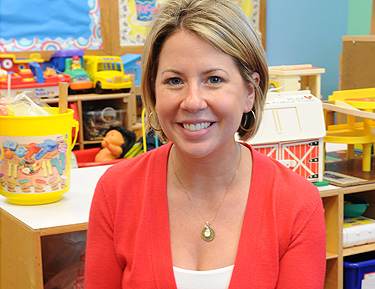Close Up
Mother’s experience guides Swartzenberg’s career path

Gretchen Swartzenberg now serves as an inspiration to her students, much as her mother’s speech pathologist served as her inspiration years ago. Photo: NANCY J. PARISI
-
 Print
Print -
 Comments
Comments
-
“Because of what had happened when I was younger, I understood what it meant to feel different.”
Gretchen Swartzenberg’s journey to becoming a speech-language pathologist began when she was 15, a high school student from Youngstown whose mother had recently awoken from a coma resulting from bacterial meningitis.
Swartzenberg’s father had died in a car crash two years before, so she and her 17-year-old sister took responsibility for their remaining parent’s care. As the siblings shuttled from specialist to specialist, one health professional stood out: a speech pathologist in the head trauma unit of the former Our Lady of Victory Hospital.
“After the meetings, she always made it a point to come up to us and make sure we understood everything, and really just checked in with us to see how we were doing—how my sister and I were doing—and if there was anything she needed to re-explain or if we needed anything,” says Swartzenberg, who remembers deciding, “I want to do what she does.”
“I don’t know who she is or where she is, but she has no idea she actually caused me to go on a certain path,” says Swartzenberg, a clinical assistant professor in the Department of Communicative Disorders and Sciences, College of Arts and Sciences, and a supervisor in UB’s Speech-Language and Hearing Clinic.
After high school, Swartzenberg attended Ithaca College, graduating in 1997 with a Teacher of the Speech and Hearing Handicapped bachelor’s degree. She then studied speech-language pathology at UB, earning her master’s degree in 1999.
Her first job was with the Clarence Central School District, where she served as speech-language pathologist for three special-education classes, working with children with autism spectrum disorders, which impair normal development of social and communication skills. She learned everything she could about disorders such as autism and Asperger syndrome, reading and attending conferences about them. She understood that for children she worked with, learning to socialize and communicate would affect every part of their lives, from making friends to getting a job.
“In them, I saw children whom, I guess, weren’t understood and struggled socially with friendships and peer relationships. …I’m a social person, so I was very empathetic toward them because I wanted to help them, to make a difference,” Swartzenberg says. “My drive to just work with them—I would be falling asleep thinking of things I could do for them. I would be eating, brushing my teeth, getting ready for work, and thinking of things I could do.
“Because of what had happened when I was younger, I understood what it meant to feel different,” adds Swartzenberg, whose mother died shortly after awakening from her coma. “I was going through real adult things, and my friends in high school were going through being kids. There was that disconnect. When I saw these kids with Asperger’s, they didn’t seem to fit with the other kids. …If the kid wanted friendships but was having trouble, I wanted to help make that happen.”
In 2002, staff at UB’s Speech-Language and Hearing Clinic called Swartzenberg, wondering if she could launch a summer social language program there to help children with autism spectrum disorders expand their vocabulary and develop such skills as following directions, asking and answering questions, and holding a conversation. She agreed, and her bosses were so pleased with her performance that they invited her to stay with the university part time to build and implement an afterschool program focusing on the same issues. By 2003, they were ready to bring her on full time.
Leaving Clarence would be difficult. Swartzenberg loved working with children. If she took the UB position, she would still have contact with clients, but her main duty would be training students and supervising them as they conducted therapy sessions. In the end, the mother of one of Swartzenberg’s Clarence students helped her make her decision. As Swartzenberg recalls, the mother told her, “Think of all the children you’ll impact in your life when you’re teaching people who want to be speech pathologists to work with children like my son.”
Today, Swartzenberg’s clinic program has expanded to include sessions for young adults—folks in their 20s, mostly—including some with autism spectrum disorders who have pragmatic or social language concerns. They practice skills related to holding a conversation, building friendships, interviewing for a job and dating. Though Swartzenberg facilitates group therapy sessions for young adults, she spends most of her time educating, observing and evaluating graduate students working with clients. She serves as an inspiration to her students in the same way that the speech pathologist who helped her mother served as her inspiration years before.
“I’m able to see not only my clients progress and develop,” Swartzenberg says, “but I’m also able to see the future speech-language pathologists become more confident, knowledgeable and successful in their therapy practice, knowing they will make a difference in the lives of the children that I adore.”

Reader Comments